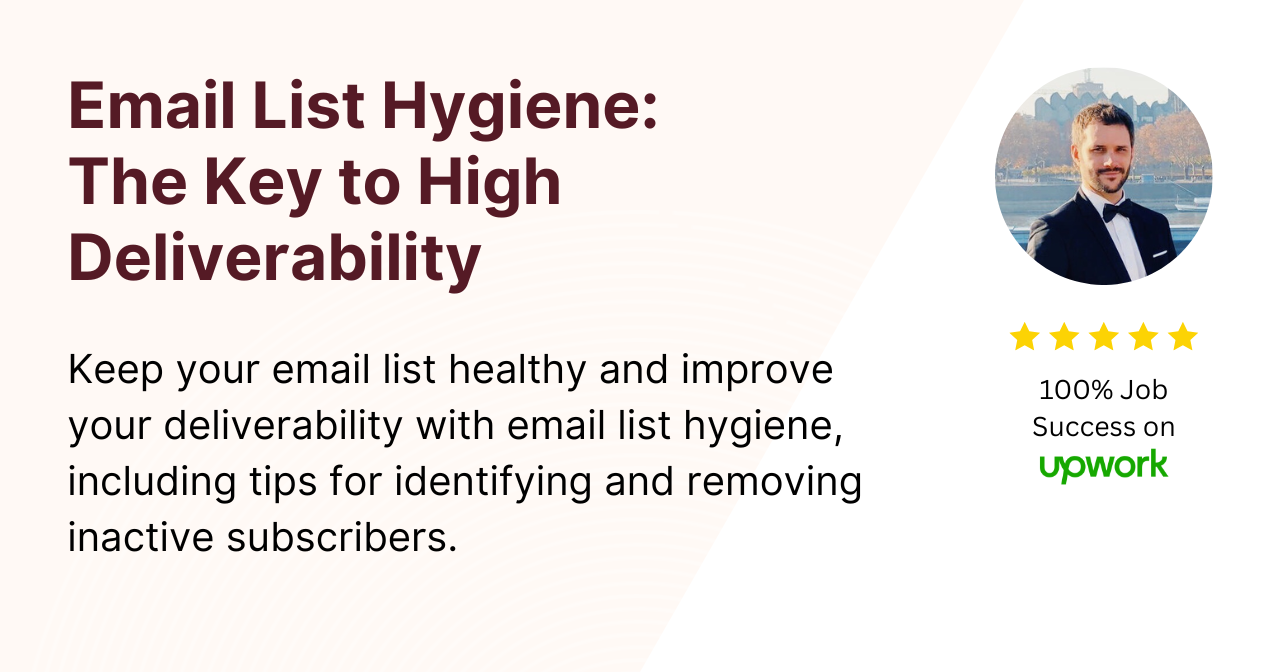If you’re running an email marketing campaign, one of the most important things you can do is keep your email list healthy.
This means regularly identifying and removing inactive subscribers.
Not only will this improve your deliverability and open rates, but it will also save you money on email marketing costs.
In this article, we’ll cover everything you need to know about email list hygiene and how to keep your list in top shape.
What is Email List Hygiene?
Email list hygiene refers to the practice of regularly cleaning your email list to ensure that it is healthy and up-to-date.
This involves removing inactive subscribers, correcting typos and misspellings, and ensuring that all email addresses on your list are valid and active.
By keeping your list clean and healthy, you can improve your deliverability rates, reduce your bounce rates, and increase your engagement with your subscribers.
Why is Email List Hygiene Important?
First and foremost, it can improve your email deliverability rates.
ISPs (Internet Service Providers) are constantly monitoring email traffic and will often block or filter emails that are sent to inactive or invalid email addresses.
By regularly cleaning your email list, you can ensure that you are only sending emails to active and engaged subscribers, which can improve your deliverability rates and help you avoid being marked as spam.
How to Identify Inactive Subscribers
These are subscribers who haven’t opened or clicked on any of your emails in a certain amount of time (typically 6-12 months).
Here are some ways to identify inactive subscribers:
Look at your email marketing analytics
Most email marketing platforms provide analytics that show you which subscribers have opened or clicked on your emails.
You can use this data to identify subscribers who haven’t engaged with your emails in a certain amount of time.
Send a re-engagement campaign
If you have a large number of inactive subscribers, you may want to consider sending a re-engagement campaign.
This is a targeted email campaign that is designed to re-engage subscribers who haven’t engaged with your emails in a certain amount of time.
If a subscriber still doesn’t engage with your emails after this campaign, it may be time to remove them from your list.
How to Remove Inactive Subscribers
Once you’ve identified inactive subscribers, it’s important to remove them from your email list.
Here are some tips for doing so:
Use a reputable email list cleaning service
There are several email list cleaning services available that can help you identify and remove inactive subscribers from your list. These services typically use a combination of automated and manual processes to ensure that your list is clean and healthy.
Remove subscribers manually
If you have a smaller email list, you may be able to remove inactive subscribers manually.
This involves going through your email list and removing subscribers who haven’t engaged with your emails in a certain amount of time.
Tips for Keeping Your Email List Healthy
In addition to regularly identifying and removing inactive subscribers, there are several other things you can do to keep your email list healthy.
Here are some tips:
Use double opt-in
Double opt-in is a process where subscribers must confirm their email address before they are added to your email list.
This can help ensure that all email addresses on your list are valid and active.
Segment your email list
Segmenting your email list involves dividing your list into smaller groups based on certain criteria (such as location, interests, or engagement).
This can help you target your emails more effectively and improve your engagement rates.
Keep your email content relevant
One of the best ways to keep your subscribers engaged is to send relevant and valuable content.
Make sure that your email content is aligned with your subscribers’ interests and needs, and avoid sending irrelevant or spammy content that could lead to them unsubscribing or marking your emails as spam.
Set clear expectations
Make sure that your subscribers know what to expect when they sign up for your email list.
Let them know how often they can expect to receive emails from you, what type of content they will receive, and how they can opt out if they choose to do so.
This can help build trust with your subscribers and reduce the likelihood of them unsubscribing or marking your emails as spam.
Monitor your email engagement rates
Regularly monitoring your email engagement rates (such as open and click-through rates) can help you identify trends and adjust your email marketing strategy accordingly.
If you notice a decline in engagement rates, it may be a sign that you need to improve your email content or adjust your email frequency.
Conclusion
By regularly identifying and removing inactive subscribers, you can improve your deliverability rates, reduce your bounce rates, and increase your engagement with your subscribers.
Use the tips and strategies outlined in this article to ensure that your email list is healthy and up-to-date.
FAQs
How often should I clean my email list?
It’s recommended to clean your email list at least once a year, but it depends on the size and engagement rate of your list.
How do I know if an email address is invalid?
If you receive a bounce-back message or a delivery failure notification, it means that the email address is invalid or inactive.
Can I re-add inactive subscribers to my email list?
You can re-add inactive subscribers to your list if they have expressed interest in receiving your emails again, such as by responding to a re-engagement campaign.
What is a good email engagement rate?
A good email engagement rate varies by industry and audience, but generally, an open rate of 20-30% and a click-through rate of 3-5% is considered good.
Can I use a purchased email list?
It’s not recommended to use a purchased email list, as these lists often contain invalid or inactive email addresses and can lead to low engagement rates and high bounce rates.
Featured image by Freepik
